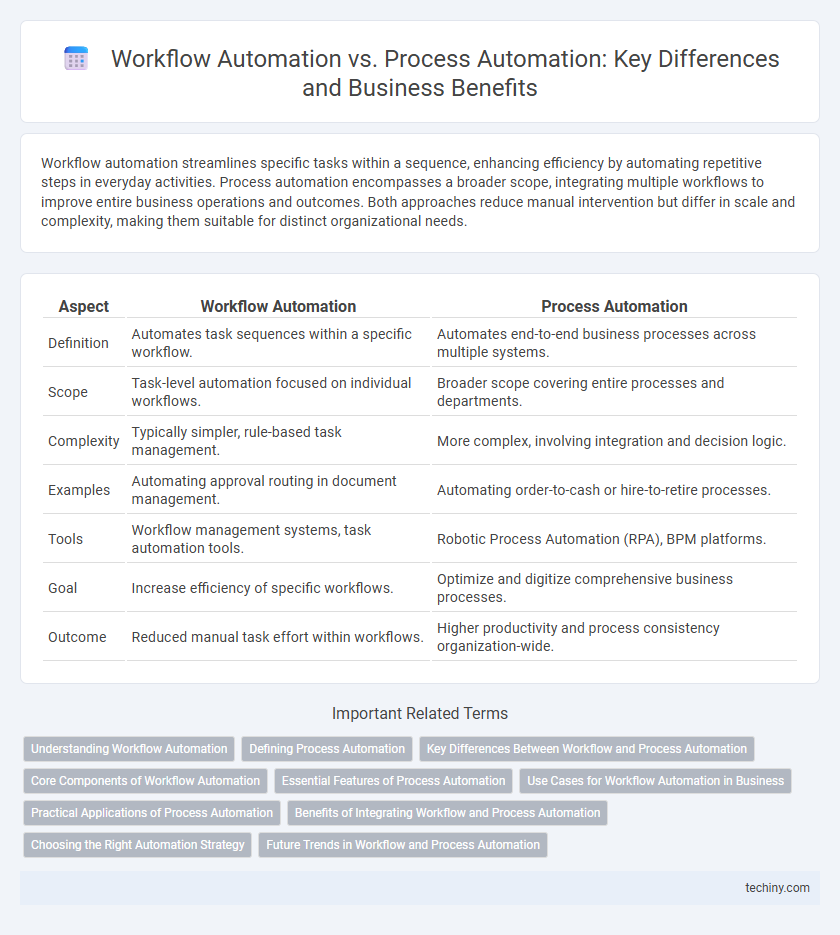Workflow automation streamlines specific tasks within a sequence, enhancing efficiency by automating repetitive steps in everyday activities. Process automation encompasses a broader scope, integrating multiple workflows to improve entire business operations and outcomes. Both approaches reduce manual intervention but differ in scale and complexity, making them suitable for distinct organizational needs.
Table of Comparison
| Aspect | Workflow Automation | Process Automation |
|---|---|---|
| Definition | Automates task sequences within a specific workflow. | Automates end-to-end business processes across multiple systems. |
| Scope | Task-level automation focused on individual workflows. | Broader scope covering entire processes and departments. |
| Complexity | Typically simpler, rule-based task management. | More complex, involving integration and decision logic. |
| Examples | Automating approval routing in document management. | Automating order-to-cash or hire-to-retire processes. |
| Tools | Workflow management systems, task automation tools. | Robotic Process Automation (RPA), BPM platforms. |
| Goal | Increase efficiency of specific workflows. | Optimize and digitize comprehensive business processes. |
| Outcome | Reduced manual task effort within workflows. | Higher productivity and process consistency organization-wide. |
Understanding Workflow Automation
Workflow automation streamlines repetitive tasks within a specific sequence to enhance efficiency and reduce manual intervention. It focuses on automating individual steps in a workflow, ensuring consistent task execution based on predefined rules. Understanding workflow automation enables organizations to optimize task management, improve accuracy, and accelerate operational processes.
Defining Process Automation
Process automation involves using technology to execute complex business processes with minimal human intervention, focusing on end-to-end tasks that span multiple systems and departments. It integrates various applications and data sources to streamline workflows, increase efficiency, and reduce errors in repetitive or large-scale operations. Unlike workflow automation, which targets individual task sequences within a process, process automation aims at optimizing the entire business process lifecycle from initiation to completion.
Key Differences Between Workflow and Process Automation
Workflow automation focuses on streamlining specific sequences of tasks and approvals within a defined framework, improving efficiency by reducing manual intervention. Process automation encompasses broader business operations, integrating multiple workflows and systems to optimize end-to-end processes for higher productivity and consistency. Key differences include scope, with workflow automation targeting task-level improvements while process automation drives holistic organizational transformation.
Core Components of Workflow Automation
Workflow automation centers on sequencing tasks through triggers, actions, and conditional logic to streamline operations efficiently. Core components include task management systems that assign and track duties, integration layers connecting diverse applications, and rules engines that enforce business logic automatically. These elements collectively enable seamless execution and monitoring of workflows, distinguishing workflow automation from broader process automation which encompasses end-to-end process optimization.
Essential Features of Process Automation
Process automation focuses on essential features such as task orchestration, rule-based decision making, and integration with multiple systems to streamline complex, repeatable operations. It emphasizes end-to-end process management, real-time monitoring, and compliance enforcement to ensure accuracy and efficiency. Workflow automation primarily handles the routing of tasks between users, whereas process automation delivers comprehensive control over business processes by automating entire sequences.
Use Cases for Workflow Automation in Business
Workflow automation streamlines repetitive tasks such as employee onboarding, expense approvals, and customer service ticket routing, boosting operational efficiency. By automating sequential activities and task dependencies, businesses reduce manual errors and accelerate project completion times. Effective use cases include automating HR processes, sales order approvals, and IT service management, all contributing to enhanced productivity and cost savings.
Practical Applications of Process Automation
Process Automation streamlines repetitive, rule-based tasks in manufacturing, finance, and customer service to increase efficiency and reduce human error. Workflow Automation organizes and automates multi-step business procedures, ensuring seamless task transitions and improved collaboration across departments. Practical applications of Process Automation include robotic process automation (RPA) in invoice processing, automated data entry in insurance claims, and real-time monitoring of production lines.
Benefits of Integrating Workflow and Process Automation
Integrating workflow automation with process automation enhances operational efficiency by streamlining task sequences and optimizing end-to-end business processes. This synergy reduces manual errors, accelerates cycle times, and boosts productivity across departments. Enterprises benefit from improved compliance, real-time visibility, and scalable automation solutions tailored to complex organizational needs.
Choosing the Right Automation Strategy
Workflow automation streamlines specific sequences of tasks to enhance efficiency and reduce manual intervention, while process automation targets entire business processes for comprehensive optimization and scalability. Choosing the right automation strategy depends on factors such as the complexity of tasks, integration requirements, and desired outcomes like speed or accuracy. Companies should assess process variability, time consumption, and technology compatibility to determine whether workflow or process automation delivers the best return on investment.
Future Trends in Workflow and Process Automation
Future trends in workflow and process automation emphasize the integration of artificial intelligence and machine learning to enhance decision-making and predictive analytics. The rise of hyperautomation enables organizations to automate complex, end-to-end business processes, combining RPA, AI, and low-code platforms. Increasing adoption of cloud-native automation tools and real-time process monitoring accelerates scalability and responsiveness across industries.
Workflow Automation vs Process Automation Infographic

 techiny.com
techiny.com